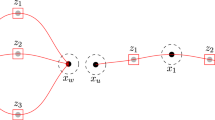Abstract
Van Lambalgen’s theorem states that a pair (α, β) of bit sequences is Martin-Löf random if and only if α is Martin-Löf random and β is Martin-Löf random relative to α. In [Information and Computation 209.2 (2011): 183-197, Theorem 3.3], Hayato Takahashi generalized van Lambalgen’s theorem for computable measures P on a product of two Cantor spaces; he showed that the equivalence holds for each β for which the conditional probability P(⋅|β) is computable. He asked whether this computability condition is necessary. We give a positive answer by providing a computable measure for which van Lambalgen’s theorem fails. We also present a simple construction of a computable measure for which conditional measure is not computable. Such measures were first constructed by Ackerman et al. ([1]).



Similar content being viewed by others
Notes
There exist two types of Martin-Löf tests relative to a non-computable measure P [5]:
-
A uniform P-Martin-Löf test is a P-Martin-Löf test that is effectively open relative to each oracle that computes P.
-
A Hippocratic or blind P-Martin-Löf test is a Martin-Löf test that is effectively open without any oracle.
If P is computable, then both types of tests define the same set of random sequences. Otherwise, the second type of tests defines a weaker notion of randomness, which we use here. Although the definition looks easier, it might not be the most natural definition of randomness relative to a non-computable measure P.
-
2 The construction has some similarities with the measure constructed in the proof of Proposition 6.3 in [2]: the measure has also singularities that approach a left computable real. However, I believe there is no deeper correspondence between this measure and the measure constructed here.
References
Ackerman, N., Freer, C., Roy, D.: Noncomputable conditional distributions. In: Proceedings of the 26th Annual IEEE Symposium on Logic in Computer Science (LICS), pp. 107–116. IEEE (2011)
Bienvenu, L., Porter, C.: Strong reductions in effective randomness. Theor. Comput. Sci. 459, 55–68 (2012)
Chaitin, G.: A theory of program size formally identical to information theory. J. Assoc. Comput. Mach. 22(3), 329–340 (1975). doi:10.1145/321892.321894
De Leeuw, K., Moore, E.F., Shannon, C.E., Shapiro, N.: Computability by probabilistic machines. Autom. Stud. 34, 183–198 (1955)
Kjos-Hanssen, B.: The probability distribution as a computational resource for randomness testing. J. Logic Anal. 2 (2010)
Lambalgen, M.V.: The axiomatization of randomness. J. Symbol. Logic, 1143–1167 (1990)
Rute, J.: Personal communication (2014)
Rute, J.: When does randomness come from randomness? arXiv preprint arXiv:1508.05082 (2015)
Shen, A., et al.: Conditional probabilities and van Lambalgen theorem revisited. In preparation (2015)
Takahashi, H.: On a definition of random sequences with respect to conditional probability. Inf. Comput. 206(12), 1375–1382 (2008)
Takahashi, H.: Algorithmic randomness and monotone complexity on product space. Inf. Comput. 209(2), 183–197 (2011)
Takahashi, H.: Generalization of van Lambalgen’s theorem and blind randomness for conditional probability. Preprint arXiv:1310.0709. Presented in sept 2013 at CCR in Moscow (2013)
Acknowledgments
This research was done on leave from Ghent University to the Higher School of Economics. The work was done partially while the author was visiting the Institute for Mathematical Sciences, National University of Singapore in 2014. The visit was supported by the Institute.
Hayato Takahashi and I visited Alexander (Sasha) Shen at Université de Montpellier 2 in France in November 2012 (both visits where supported by the project NAFIT ANR-08-EMER-008-01). I am very grateful for the intense discussion on the proof of Theorem 3 and for raising the question answered in this note. Understanding this proof was important to prove the main result here. Several simplifications of the proof here were made also by Alexander Shen.
I thank Jason Rute for useful discussions and the reviewers for quick feedback and useful comments.
Author information
Authors and Affiliations
Corresponding author
Appendix Two Definitions of Conditional Measure Coincide
Appendix Two Definitions of Conditional Measure Coincide
In probability theory, conditional measures are defined implicitly using the Radon-Nikodym theorem. Any measure that satisfies the conditions of this theorem can be used as a conditional measure. The following lemma states that such measures are almost everywhere equal to the conditional measure P C defined above.
Lemma 2 (Folklore)
Let 2 ∗ be the set of strings. For every measure P on \(2^{\mathbb {N}} \times 2^{\mathbb {N}}\) and for every function \(f: 2^{*} \times 2^{\mathbb {N}}\) such that for all x and y
we have that f(⋅,β)=P C ([⋅]|β) for all β in a set of P M -measure one.
In the proof we use the Lebesgue differentiation theorem for Cantor space. The proof of this version follows from the proof for Real numbers.
Theorem 6 (Lebesgue differentiation theorem for Cantor space)
Let Q be a measure on \(2^{\mathbb {N}}\) . For every Q-integrable function \(g:2^{\mathbb {N}} \rightarrow \mathbb {R}\) we have that
for Q-almost all β.
Proof Proof of Lemma 2
For a fixed x, apply the Lebesgue differentiation theorem with g(⋅) = f(x,⋅) and Q = P M . By assumption on f, the nominator simplifies to P([x],[β 1…β n ]). It follows that f(x, β) differs from P C ([x]|β) in at most a set of β with P M -measure zero. Because there are countably many strings x, it follows that f(⋅,β) and P C ([⋅]|β) differ in at most a set of P M -measure zero. □
Rights and permissions
About this article
Cite this article
Bauwens, B. Conditional Measure and the Violation of Van Lambalgen’s Theorem for Martin-Löf Randomness. Theory Comput Syst 60, 314–323 (2017). https://doi.org/10.1007/s00224-016-9675-3
Published:
Issue Date:
DOI: https://doi.org/10.1007/s00224-016-9675-3




